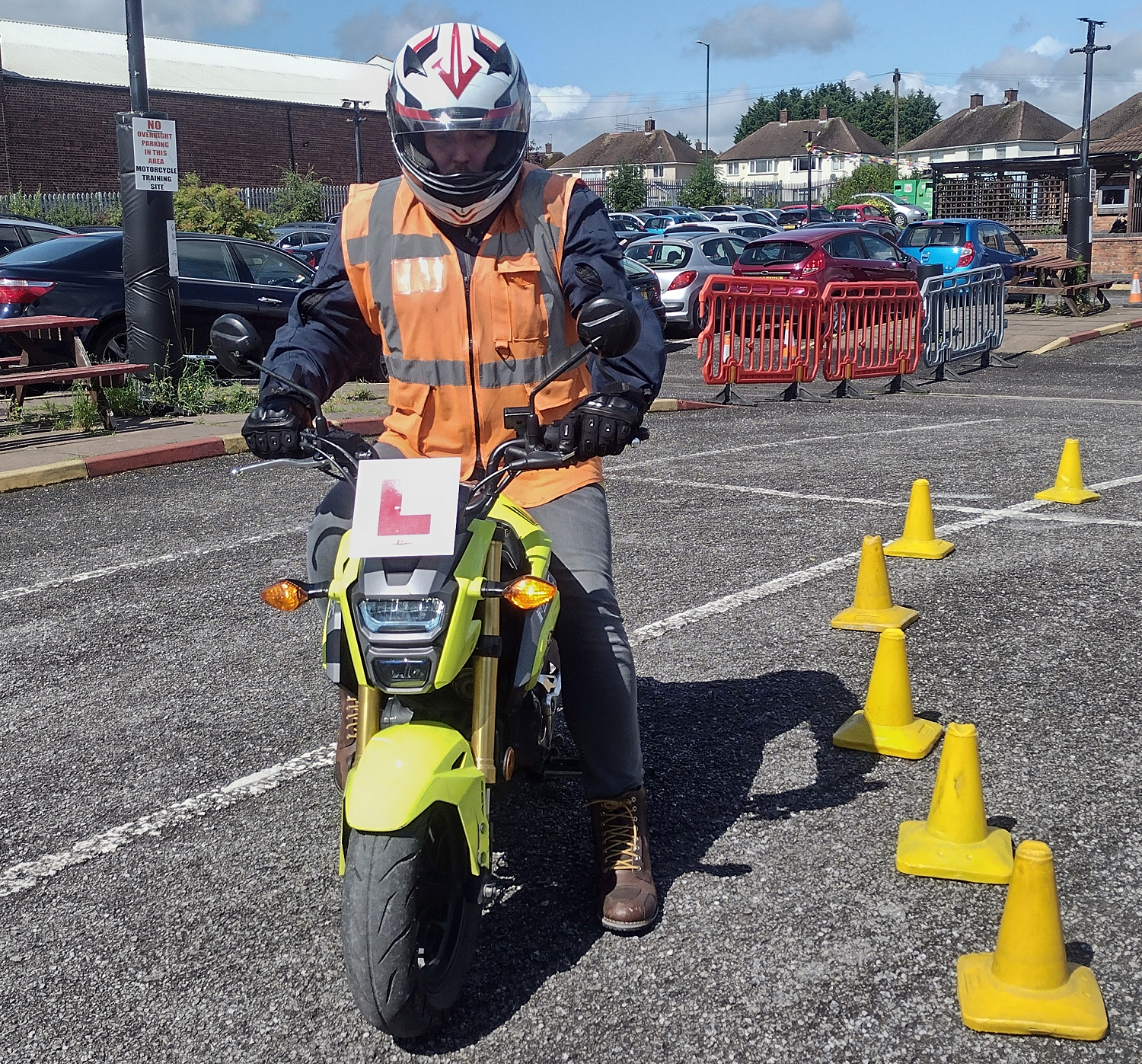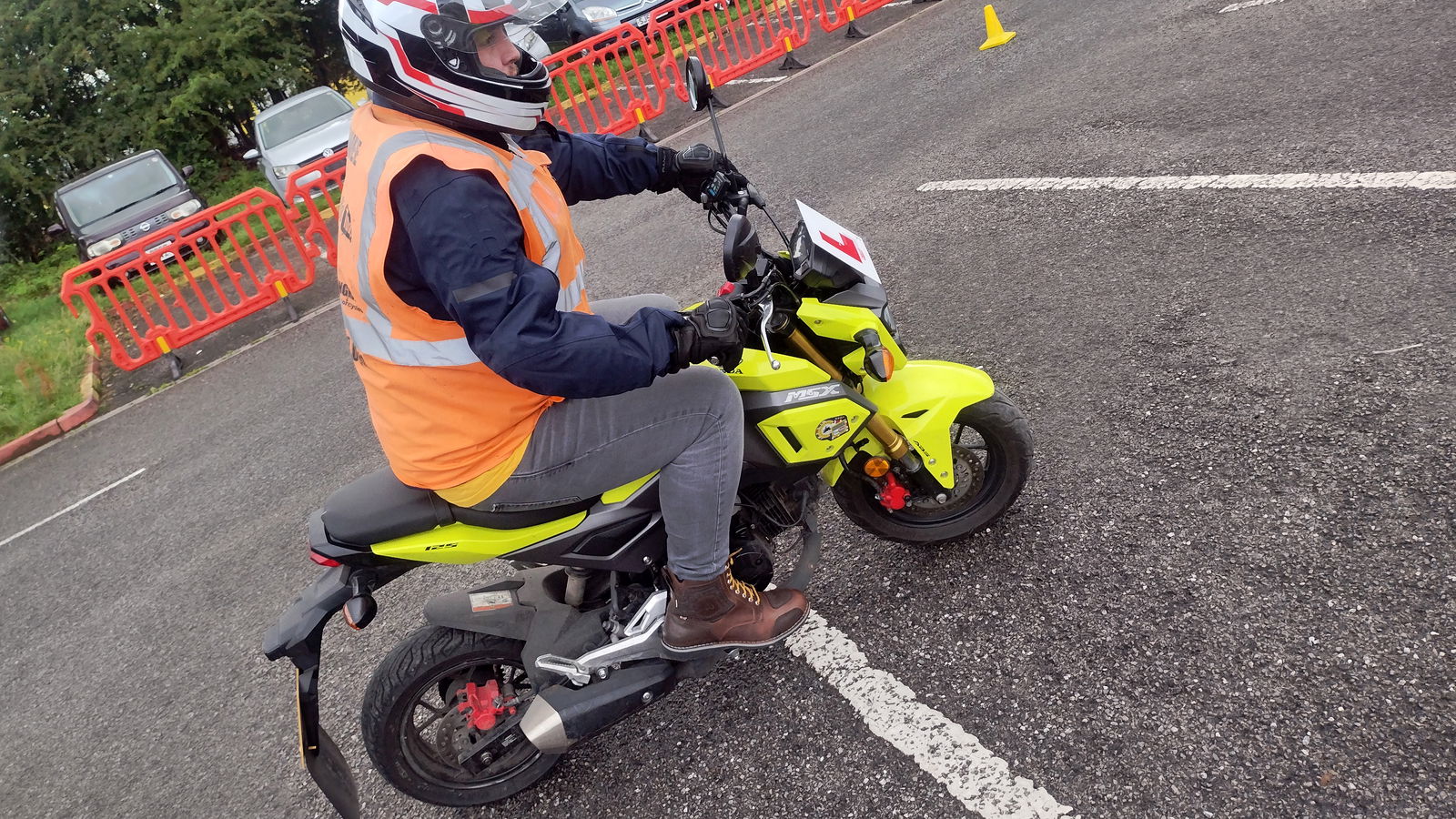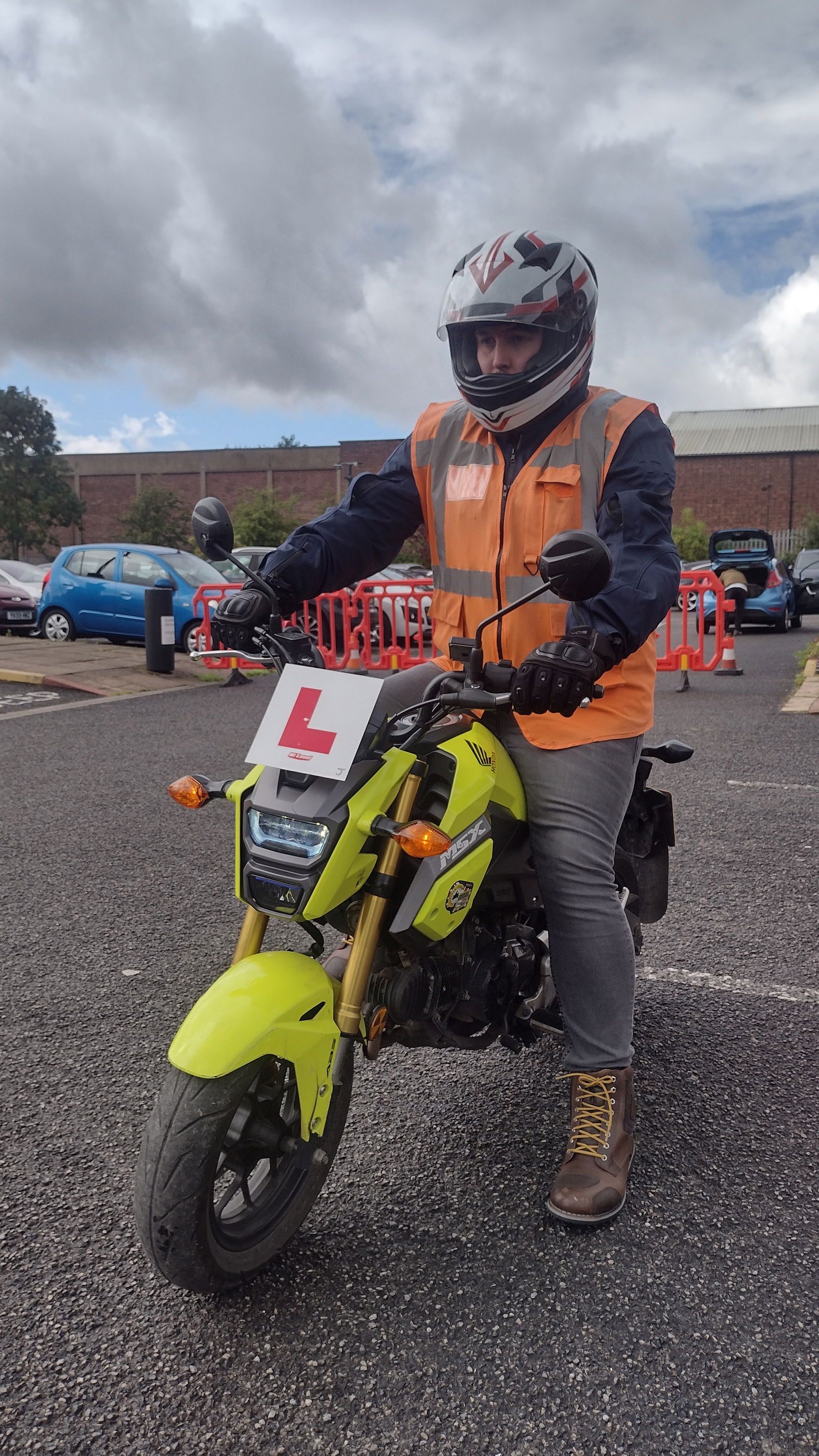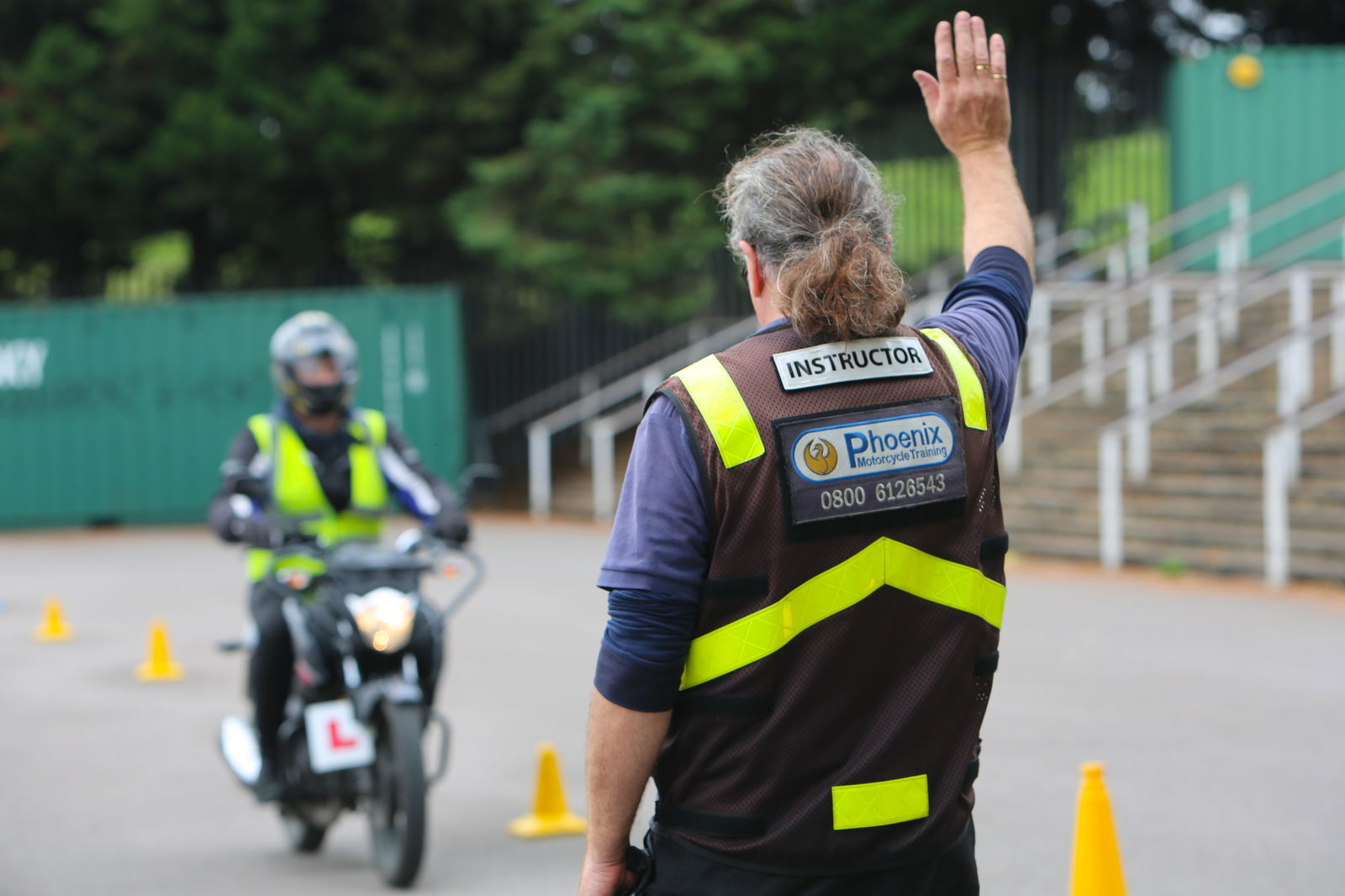Taking a motorcycle CBT: My experience
A motorcycle CBT can feel like a daunting prospect but, in reality, minimising pressure can lead to an enjoyable and fulfilling experience.

I started working at Visordown in February 2022, but I had not taken a motorcycle CBT nor even ridden a motorcycle before. This, of course, needed fixing, but it took me a few months to do anything about it.
Thanks to some organisation via Honda and Visordown’s chief wordsmith Toad and fixed it has now been.
Overview
Do I need lessons before a CBT?
What does a CBT involve
Do I need lessons before a CBT?
Honda sorted out two one-hour, one-to-one introductory lessons for me at one of its officially licenced riding schools, specifically the Roadcraft School of Motorcycling in Nottingham.

For my first lesson, I was - as you might expect - a total bag of nerves. This somewhat showed in my riding, which was pretty sketchy for that first hour. I found encouragement, though, in that my learning pattern seemed similar at this early stage to when I was learning to drive: I started off okay, and then my level slipped as more complexity was added, but I understood what I needed to do, it was just a case of putting all of the pieces together.
As those of you who have been through the CBT before will know (which I am assuming will be most of the people reading this), the first riding you do - various manoeuvres at slow speed in a car park - is pretty much all about clutch control and not going near the front brake. My early problems were trying to control the engine with the throttle, not the clutch, and reaching for the front brake when I needed to slow down, not pressing on the rear brake. When shifting gears was added to the equation, the progress I felt had made in these two areas pretty much went straight out of the window. And that’s where the first lesson ended.
I had made some headway during the one-hour session, but my instructor Rich let me know that if I tried to do the CBT after only that hour I would find it very hard to pass. So, taking a second lesson was a pretty easy choice for me.
It was also a good choice to make. It meant that I could take the time to process everything I had learned in that first hour and work out what I needed to do to end the second one in a position where taking the CBT would be likely worthwhile. Mostly, these improvements were about slowing my brain down, slowing the bike down, and giving myself time to do things properly. For example, I would rush the shift from second gear to first, and find myself in neutral unknowingly, I would pull the clutch to shift up without rolling the throttle, then let the clutch out too far and let the engine take over; and I would do all of these things within a few seconds of each other, lose control of my speed, take a terrible line in the corner and end up almost hitting the kerb on the exit of the corner - all because I was distracted by the initial mistake of mis-shifting.
The time to process these mistakes meant that, in the second lesson, I was making them much less, my riding improved, and in actuality the one-hour lesson was more or less over after 40 minutes, which meant I could practise U-turns. After the second lesson, therefore, I felt much more confident, and no longer felt like I would just tip over as soon as I began a corner.
After the second lesson, I had one month before my actual CBT. For most people, the time between an introductory session and the CBT would be less than this.
For me, the one-month gap between the lesson and the CBT had its positives and negatives. For a week I was thinking about my weak points, but with confidence that I could work them out; for the last three weeks that confidence dwindled.
However, that there was confidence there to dwindle was entirely thanks to the two lessons. I would say that, since the ‘T’ in CBT stands for ‘Training’, lessons are not mandatory, but I would recommend them, especially if you haven’t ridden anything more than a bicycle before, or if you generally have quite low confidence. Additionally, it is worth noting that some riding schools will mandate lessons for you. This was the case for me with Roadcraft as soon as they established I hadn’t ridden a motorcycle before.
What does a CBT involve?
Although I knew I could ride, I did not know whether I would be able to ride among peers and I did not know whether I would be able to ride at a good standard in a more pressurised scenario as is presented by the CBT itself, which, for me, began at 09:00 and finished at around 14:00, but which can last up to eight hours.

This, though, was perhaps mostly because I was still thinking about the CBT as a six-hour test rather than six hours of training. A mistake, because the expectation of someone taking their CBT is not that they should start the day as someone who is ready to ride on the road alone, but that they should end the day in that state.
CBT theory
The CBT itself began with a kind of theory session, but instead of the intensity of a four-wheeled theory test, this part of the CBT was more of a group session. The instructor would pose questions - about bike maintenance, road etiquette, and clothing requirements, for example - and the group (there were four of us pupils, including me, on this occasion) would answer. With some questions, the instructor would ask for an answer from each individual pupil, on others it was more open. But, it was more of a lesson than a test of knowledge, and by the end of it our knowledge was supposed to have improved compared to what it was beforehand.
For example, I learned that mopeds need only visible tread on their tyres to be legal, with no depth requirement, that a Honda CB500X has an oil level monitor near the clutch cover, and that a reduction in the level of brake fluid indicates wearing brake pads. Should I have known all of that before (especially as someone who makes writes about motorcycles for a living)? Probably, but the point is that I know them now - because of the CBT.
CBT car park manoeuvres
But, no one takes their CBT to talk about bikes, they take it so they can ride bikes. That part of the course came, as you might expect, after the theory section’s final segment - that being about the motorcycle’s controls.
The riding segment of the CBT starts in the car park, and with a series of manoeuvres. The first is simply walking the bike around. This involves no use of the engine, not even turning it on, and literally just walking alongside the bike.
Speaking of the bike, I rode a Honda MSX125 Grom for my CBT, which I was happy enough with as it was with this that I had done my two introductory lessons. It also proved to be helpful in other aspects. For example, the car park manoeuvres are all, to some extent, concerned with manoeuvring the bike in tight spaces, and the MSX’s small, 12-inch wheels I feel helped in these slow speed, tight scenarios. Additionally, its low seat height was a help in having both feet down whenever stopped.

The main downside to riding the Grom the bike’s lack of gear indicator on the dashboard.
The manoeuvres after turning the engine on grew in complexity as the time advanced. First was simply setting off, stopping, and then riding in an oval around the car park. On maybe the fourth corner, I almost stacked it on a kerb. The error was at the start of the corner, entering too tightly, and the result was having to stop before hitting the kerb on the exit. Embarrassing, but not day-ending, and I didn’t do it again.
The oval we were riding around had a line of cones in the middle of it. After a few laps of the oval, I was instructed to slalom between the cones, which simply as a manoeuvre when flowing the direction changes together.
Next up was the figure-of-eight, which is as it sounds. Two cones are laid out in the middle of some parking bays, and you ride between the cones in a figure-of-eight, staying between the outer bounds of the parking bays the cones are in the middle of.
While clutch control was important in the slalom and the oval to maintain control of the speed, it was of even greater importance in the figure-of-eight because of the combination of limited space, longer turns and direction changes.
The remaining manoeuvres were the U-turn, left and right turns, and controlled and emergency stops.
First, the U-turn involves a check of both mirrors before setting off, a shoulder check before initiating the turn, completing the turn within the prescribed boundaries, and coming to a stop once the turn is completed. This is most-complicated by over-exaggerating the shoulder check before turning, resulting in a loss of balance. Clutch control is important again here because, if you lose control of the speed at any point before you start turning then that issue is going to compound itself the further around the corner you get as you try to decelerate without losing balance.
Another new element was introduced for the next two manoeuvres, controlled and emergency stops: the front brake. Until then, only the rear brake had been necessary or desired, but now the manoeuvres were simulating on-road scenarios, so the riding was instructed to match.
Because of the previous instruction to avoid the front brake, I had managed to develop the scenario in my head that I would be holidaying in Endonesia the second I reached for the lever on the right bar. It was not the case in reality and, in fact, I could apply a lot more pressure to the front brake than I thought.
This was beneficial for especially the emergency stop. The controlled stop was straightforward: check both mirrors, decelerate, shift from second to first, and stop. On the other hand, the emergency stop was more complicated, because understanding exactly how hard to squeeze the lever to get pulled up in a decent distance required a few attempts (at least for me). An important thing to remember about emergency stops is that stalling is unimportant. The emergency you are stopping for is more important than your ability to remember to clutch-in when faced with that emergency.
Left and right turns are a process of elimination. It is the same as in a car to an extent: mirror, mirror, indicate, shoulder check (the difference to a car), position (which side of the road depends on which direction you are turning, of course), decelerate to a stop, check your exit is clear, pull away, and cancel indicator.
It is a straightforward manoeuvre, but for me it was a case of just putting the whole sequence together in the right order without forgetting the basics of riding. Sometimes I would indicate before I checked the mirrors, for example, or other times I would get the sequence right and then mysteriously decide to change down without the clutch, or think (somehow) I was in race shift and push the lever up instead of down as I sought first gear. It is just a case of repetition. Eventually, you iron out the mistakes one at a time, and you get it right.
CBT road ride

When we eventually headed out of the car park and onto the road, I found that the grasp I had on riding began to slip. By now we had been split into two pairs, each pair assigned to one instructor, who rides at the rear of the group and communicates via a one-way radio (not entirely dissimilar in concept to the kinds of systems that have been and are being trialled in MotoGP, only CBT pupils are not riding on the limits of physics). I led at the beginning and, turning right out of the car park, I wobbled up to the end of the exit road and almost immediately toppled over because I was so apparently fascinated by the process of indicating. Then, I forgot to check my mirrors, made the longest shift from first to second gear in the history of transmissions, and, at the first right turn, positioned completely wrong, carried too much speed, and got lucky about a kerb ending on the corner exit - if it hadn’t, I’d have been down.
From there, the riding improved a bit, the aforementioned grasp somewhat returned. There were some lingering positioning issues, as well as some indicator cancellation negligence.
With regards to positioning, it is a bit more complicated than in a car. The size of a car means that there is essentially one road position - down the middle - because a little bit too much to the right and you’re clipping the door mirrors of oncoming traffic, and a little bit too much to the left and you’re launching yourself off a kerb and attempting your best Ari Vatanen impression (as in, flipping violently through the air, not winning the WRC in an Escort).
The general idea is fairly clear: create as much distance between yourself and a potential hazard as possible. In the event the maximum distance you can create is not very much, slow down.
Perhaps it is a side effect of driving, but I found myself in what was called ‘Position 3’ quite often. This means I was on the right-hand side of my lane, which makes sense as someone who drives a right-hand drive car. The opposite, the left-hand side of the lane, is called ‘Position 1’, and the centre of the lane is called ‘Position 2’, which should be considered the ‘default setting’ you are always trying to return to.
After my early sketchiness riding around some quiet 20-limit roads, we headed to a kind of quiet industrial area to practise some of the manoeuvres we had already tried in the car park. In particular, we did U-turns and emergency stops. The U-turns were fine, in fact they were much easier than in the car park because of the additional space on the road. It was just important to pay actual attention to your observations because, whereas in the car park you were pretty much doing it to fulfil the criteria of the manoeuvre, on the road there was the legitimate opportunity for a hazard to appear.
In comparison, I found the emergency stops more difficult. This was for the specific reason that every time I reached for the front brake I also grabbed a bunch of throttle. I was not doing this intentionally, of course, but instead it seems like a negative manifestation of a positive habit picked up in the car park. There, the speeds were low, so the engine was controlled with the clutch, so I had to try to force myself to keep the throttle rolled on even when I was trying to slow down. In the case of the on-road emergency stop, I was now rolling the throttle, grabbing the brake, and then re-applying the throttle as I was stopping. It was nothing more than an incorrect connection in my head, but it took three or four attempts to iron it out.

Since it was me who had led to the industrial area my pair led us off from there, so I was now in the middle of the group.
Rushing is a characteristic of both my driving and riding, it turns out and, in the case of downshifting on the bike, it meant that I was not letting the lever properly reset between shifts, so I would be pushing down twice but only downshifting once, for example. In hindsight, it should have been obvious from the feeling of the bike and the presence - or lack thereof - of the ‘click’ of a successful gearshift. But, because I was rushing, I cut corners and made assumptions: “I don’t know I’m in second, but I probably am.” Often I wasn’t, though, and I would find myself trying to pull away from a dead stop in second, or even once in neutral. None of those, can you believe, are effective methods of setting off, and I ended up stalling on multiple occasions.
My justification for rushing, in the moment, is always that I am trying to not hold people up. But it is a ridiculous justification, and not one at all really, because by rushing you make mistakes, and then you hold people up anyway.
I would say that the vast majority of mistakes I made both on the road and in the car park were because I was rushing. As I said before, this was better between after the lessons, but it was not gone completely.
I would say that, if you are going to take your CBT, one of the most important things you can be is conscious and deliberate about taking your time.
Riding back to the shop, I stalled again, this time on a busy roundabout, and once again because I was rushing, and then I nearly stacked it when traffic lights halfway around that same roundabout turned red as I approached. I was informed that this, too, was because I was rushing.
Throughout the road ride I’d noticed two particular things about my riding that were not about rushing: that I was very nervous to use the front brake really at all; and that I would naturally lean out of a corner with my body which was not beneficial for my line through the corner or for avoiding the hedge on the outside. These were the things that I felt like I needed to improve on the most in terms of my actual riding technique that were beyond simply rushing and not thinking properly.
Eventually, we got back to the shop and, eventually, I was told that I’d passed, which was a relief, not least because I no longer had to spend any more time as a motorcycle journalist who cannot legally (or otherwise, to be fair) ride a motorcycle.
My CBT success was in no small part down to Honda, of course, who, as I mentioned at the top, helped to organise the whole thing; but especially to everyone at the Roadcraft School of Motorcycling in Nottingham, who were happy to inform me of my level whether it was good, bad or otherwise, and who did not tell me to go away when I had to cancel my second introductory lesson twice due to travel complications on my side. It was also thanks to Vertu Honda, who help provide Roadcraft with motorcycles, and keep their fleet up to date.
If you are in Nottingham, or it is within a reasonable distance for you to travel, and you want to book a CBT or introductory lesson, head to the Roadcraft website to see how they can help you out.

